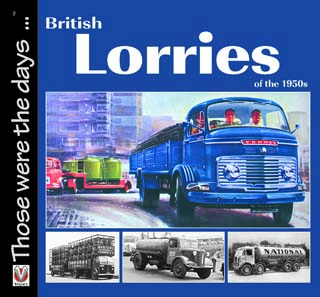British Lorries of the 1950s & 1960s by Malcolm Bobbitt – Review

by Colin Barnett
When you’re fuming at being stuck behind a 44-tonne artic overtaking another on the A1, it’s easy to forget that almost every possession you have spent some of its journey to you inside one of them. Nowadays, with the solitary exception of Daf, which still builds some of its models across the Pennines, at Leyland, those lorries will have been built on the other side of the English Channel.
But it wasn’t always so. Until the final quarter of the 20th Century, Great Britain had a thriving lorry manufacturing industry, serving not just the home market but many more across the globe. The reasons for its downfall are many and varied, but can be boiled down to the same lack of investment and imagination to counter the threat from overseas that did for our motorcycle industry around the same time.
In road transport, as in so many areas of British life, the two decades featured in these books saw changes that were almost beyond belief. In 1950, much of the equipment still in use had been designed before World War 2, and materials, especially steel, were scarce. The drive to earn desperately needed foreign cash meant that what steel was available was largely reserved for exports. As a result, aluminium and fibreglass became more widely used.

“Your own best remembered lorry will almost certainly appear”
It wasn’t really until the second half of the sixties, and the arrival of innovative designs such as Leyland’s Ergomatic tilting cab, that the foundations for today’s trucks were laid. Power sources were also still in a state of flux. The last Sentinel steam lorries were built in 1950, and petrol engines were still commonplace, although by the end of the ‘sixties, diesel had come to dominate almost totally, notwithstanding a brief flirtation with gas-turbines.
For many people born before decimalisation came and changed the face of the country for ever, their first memory of a lorry will be one of those classic British makes. Whether the ubiquitous Bedford, the thoroughbred Atkinson or the quirky Scammell three-wheeler that nipped in and out of every railway goods yard, your own best remembered lorry will almost certainly appear in one of this pair of books.
Within their near 100 pages each, they provide a broad but necessarily shallow look at the lorries from the two decades. Illustrations are a nice balance of contemporary photography, much of it in colour, and the hand-painted “artist’s impressions” style popular in advertising in the day, together with a sprinkling of modern images of restored vehicles.
‘Those were the days… British Lorries of the 1950s’ and ‘Those were the days… British Lorries of the 1960s’ by Malcolm Bobbitt, published by Veloce, £15.99 each









